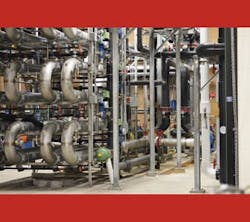A waste-to-energy project, the first of its kind in the Milwaukee area and one of the largest merchant facilities in the Midwest, takes high-strength liquid residuals—previously handled as a waste stream from food and beverage industries—and utilizes them to generate electricity and heat. In essence, the facility is converting what was previously a waste product into a valuable renewable fuel source.
The $20-million renewable energy facility uses a proprietary anaerobic digestion process to convert liquid organic waste, referred to as feedstock, into biogas. The biogas serves as a renewable fuel source to power two 1-MW generators that produce electrical power and heat.
Partners in the project included Greenfire Management Services LLC; Miron Construction Co. Inc.; Symbiont – Science, Engineering and Construction; Titus Energy; Biothane LLC; Natural System Utilities LLC; and Marquette University.
Project Background
Processing operations at many food production facilities create high-strength organic waste streams. These waste streams have typically been discharged to publicly owned wastewater treatment plants or hauled to agricultural land and spread on farm fields as fertilizer. In order to maintain water quality in lakes and streams, however, continued tightening of environmental regulations are making some of these disposal alternatives—especially land spreading—increasingly challenging. The Forest County Potawatomi Community (FCPC) facility provides a clean alternative, processing high-strength wastes from more than 10 food production facilities located in southeast Wisconsin. The facility treats these high-strength wastes to generate biogas, which is used to produce electrical power and heat.
The project is located on a 2.6-acre site adjacent to the Potawatomi Bingo Casino in Milwaukee’s Menomonee Valley.
The most visible features of the project are the two 1.3-million-gal tanks (biodigesters), where the liquid food waste is converted into biogas. In the biodigesters, microorganisms biologically assimilate the high-strength wastes in the absence of oxygen and generate biogas (e.g., methane). The biodigesters treat 100,000 to 130,000
gal per day of high-strength wastes to generate about 700 cu ft
per minute of biogas. The biogas is filtered, dehumidified, compressed and used in two internal combustion engines to generate
2 MW of electrical power. The facility also includes heat recovery equipment that will allow it to take heat from the engines and reuse it for domestic hot water at the Potawatomi hotel. A 15,000-sq-ft building houses the pumps, heat exchangers, gas treatment and electrical equipment, and engine generators.
Economic & Operational Benefits
The FCPC had the vision to look at the unique waste stream and see a fuel source. Its efforts have provided economic and operational benefits to multiple stakeholders as well as its own community. The U.S Department of Energy (DOE) and Focus on Energy, a Wisconsin utilities’ energy efficiency and renewable resource program, were key partners in the planning and implementation of the project. DOE awarded the FCPC a $2.6-million grant to cover a portion of the project’s capital costs.
The FCPC will benefit from revenue through the sale of the electrical power it generates. It has an agreement with We Energies to purchase this power.
Local food processors also have an alternative option to disposing of high-strength waste stream on agricultural land or at a local wastewater treatment plant. As a result, these industries will benefit economically from reduced disposal costs and have a sustainable means of handling the residual streams from their production processes.
We Energies, in entering the agreement to purchase power from the FCPC, continues to build up its capacity to produce green electrical power and is working toward meeting the utility’s state and federal renewable energy milestones.
The facility’s operation and maintenance have created four direct full-time jobs, in addition to the 75 to 100 construction jobs necessary to build and start up the facility.
Environmental Advantages
The culture and traditions of the FCPC establish a duty to protect and enhance the environment. The biodigester project attests to the community’s commitment to this duty. The project adds 2 MW of clean, sustainably produced electricity to the grid, seeking to reduce reliance on fossil fuel-generated energy. In addition, by “reclassifying” the high-strength waste streams as a feedstock/renewable fuel source, the community has provided a more sustainable alternative to area food processors for the disposal of residuals, working to avoid harmful runoff associated with other disposal options and treating the material in an environmentally beneficial manner. The facility will allow all involved to be both environmentally and fiscally responsible, which makes the community a better place to live and work.
Download: Here


